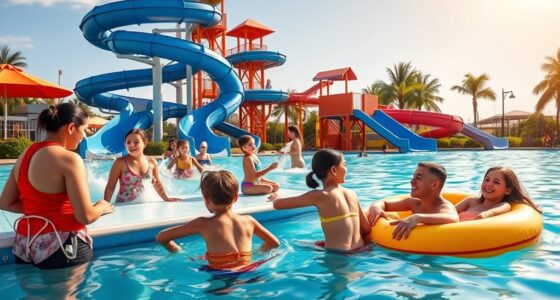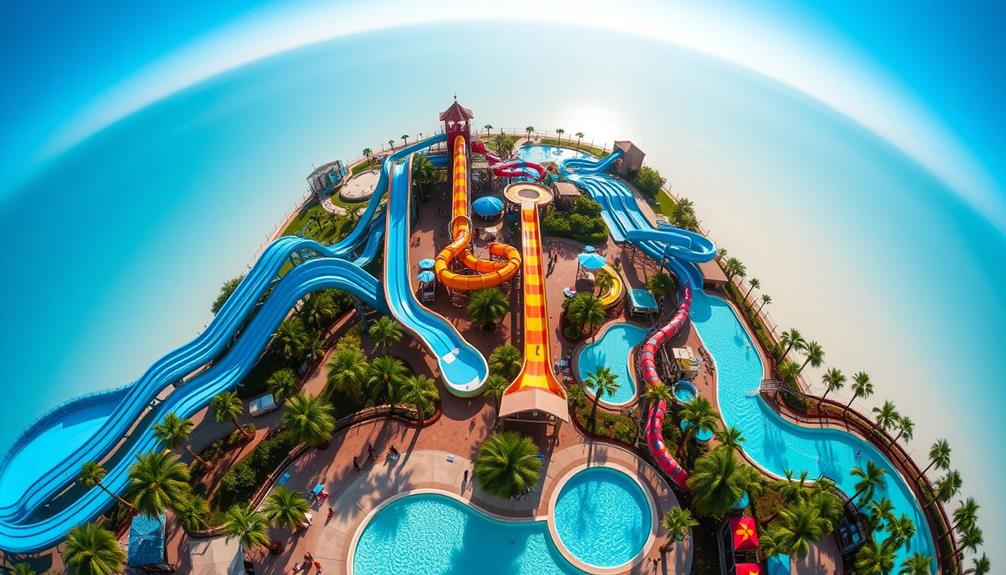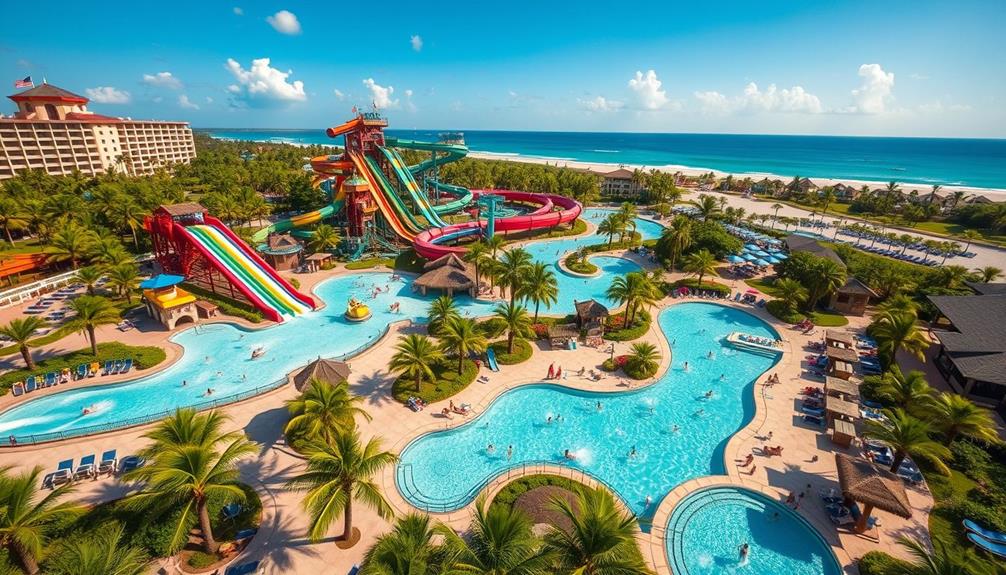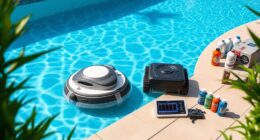To capture the perfect splash at a water park, you'll want a DSLR or mirrorless camera with a fast shutter speed of at least 1/1000 seconds. Use a macro or telephoto lens to maintain distance and focus on the action. Set your ISO around 100-200 for clarity and choose a smaller aperture like f/8 to f/16 for depth of field. Consider using flash to freeze the motion, and try shooting in continuous mode for multiple frames. With the right gear and a few clever techniques, you can elevate your water park photography. You'll find even more useful tips to enhance your skills.
Key Takeaways
- Use a fast shutter speed of at least 1/1000 seconds to effectively freeze water splashes in action.
- Opt for a DSLR or mirrorless camera with a macro lens for detailed close-up shots of splashes.
- Employ flash techniques, such as fast duration and high sync speeds, to enhance lighting and freeze motion.
- Maintain a low ISO setting (100-200) for clarity while adjusting aperture between f/8 to f/16 for depth of field.
- Protect your equipment with waterproof housing and use longer lenses to keep distance from splashing water.
Essential Photography Gear
When it comes to capturing the excitement of a water park, having the right photography gear is essential for getting stunning shots. Start with a DSLR or mirrorless camera, as they give you better control over your camera settings and greatly enhance image quality. Pair this with a 100mm macro lens; it's perfect for capturing detailed water splashes and fast action, ensuring you get those dynamic shots.
Additionally, consider using the best apps for finding deals on photography equipment, which can help you save money while upgrading your gear Best Apps for Finding Deals.
To prevent camera shake while shooting fast-moving subjects, a remote shutter release is a must. This little gadget helps you snap pictures without jostling your camera.
Additionally, a sturdy tripod is essential for stabilizing your shots, especially in low-light conditions or when using slower shutter speeds to create unique effects.
Don't underestimate the power of lighting! Flash or strobe lights can dramatically enhance the detail in your water shots and freeze motion effectively.
Position multiple light sources for even illumination, which will help you capture those exhilarating splashes with clarity. With the right gear in hand, you're set to take your water park photography to the next level.
Camera Setup and Settings
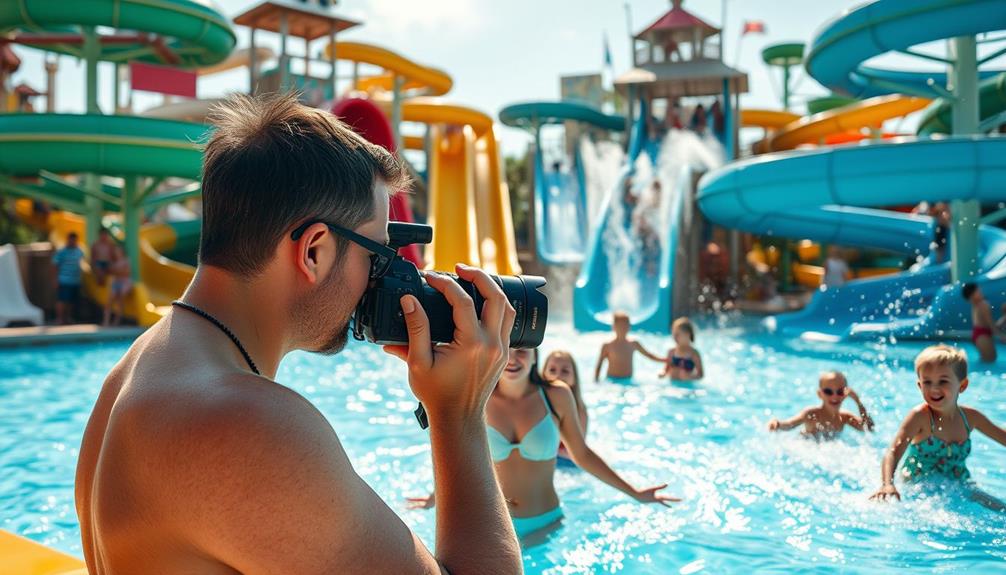
To capture those thrilling moments at the water park, you need to get your camera settings just right. Start by selecting the ideal shutter speed, aperture, and ISO to freeze the action and maintain clarity in your shots.
Consider that different environments, such as indoor water parks in Michigan, may require specific adjustments to your settings due to varying lighting conditions.
Don't forget to choose the right lens and consider how flash can enhance your photography in bright, reflective environments.
Ideal Camera Settings
Capturing the excitement at a water park requires the right camera settings to confirm you get stunning images of splashes and action. Start with a fast shutter speed of at least 1/1000 seconds or faster. This will effectively freeze the action of water splashes and movement, guaranteeing you don't miss those perfect moments.
Additionally, consider the ambient noise levels and light conditions at the park, which can also impact your settings for best results when capturing dynamic scenes in an outdoor environment, especially when utilizing music production essentials.
Next, set your ISO around 100-200. A low ISO minimizes noise, helping you achieve clear, high-quality images, especially in the bright sunlight often found at water parks. For your aperture, choose a setting between f/8 and f/16. This range provides a good depth of field, allowing you to keep both your subject and surrounding water splashes in sharp focus.
Don't forget to utilize continuous shooting mode. This feature lets you capture a burst of frames in quick succession, increasing your chances of getting that ideal splash shot.
Lens Selection Tips
Choosing the right lens can make a significant difference in your water park photography. A 100mm macro lens is fantastic for capturing splashes and water droplets with incredible detail, similar to how one might appreciate the unique flavor insights of specialty coffee beans. Its ability to focus closely guarantees sharp images, revealing the beauty of each splash.
If you're aiming to freeze motion in fast-moving water scenes, opt for a high-speed lens with a wide aperture, like f/2.8. This will allow you to use fast shutter speeds, essential for dynamic environments.
Additionally, consider a lens with image stabilization to minimize blurriness caused by camera shake, especially when you're shooting amidst all the action.
If you prefer to maintain a safe distance from the water, a telephoto lens can help you frame your subjects without risking your camera. Just remember to check lens compatibility with your camera body to guarantee everything works smoothly.
Flash Usage Techniques
Flash can be a game-changer in water park photography, helping you capture stunning images amidst the bright sunlight and fast-moving water. To effectively freeze motion and capture crisp details of splashes, use a fast flash duration—ideally under 1/2000 sec.
Coupling this with a high sync speed (above 1/250 sec) prevents ambient light from affecting your exposure, allowing the flash to dominate the image. Additionally, ensuring that your shooting environment is free of pollutants can further enhance your image clarity, much like using ozone air purifiers to improve indoor air quality.
Mirror lock-up mode is your ally in minimizing camera shake, which is essential when you're capturing fast-moving water activities. Adjust your aperture to f/11 to f/16 for a sufficient depth of field, ensuring both the splashes and your subjects remain in focus. This setting will also help maintain sharpness across the frame.
Keep your ISO levels low, around 100, to minimize noise in your images. The flash will compensate for proper exposure, even in bright sunlight.
Techniques for Capturing Splashes

To capture stunning splashes at a water park, you'll want to pay attention to flash duration and ideal camera settings. A quick burst of light can freeze the action, making those droplets pop in your photos.
Additionally, ensuring that your equipment is clean and free from any obstructions can enhance the overall quality of your images, similar to how regularly cleaning candle holders can prevent soot buildup.
Flash Duration Importance
Often overlooked, flash duration plays a significant role in capturing stunning water splashes. When you want to freeze action and reveal the beauty of those dynamic moments, understanding flash duration is key. A fast flash duration, specifically t 0.1, measures around 1/5000 seconds, making it perfect for capturing rapid movements in low-light environments.
Just as understanding thermal energy transfer is essential for enhancing heat pump performance, mastering flash duration can elevate your photography skills.
Here are three important tips for using flash duration effectively:
- Choose the Right Flash Setting: Set your flash to around 0.05 seconds to synchronize with the moment of impact, ensuring optimal exposure and clarity in your water splashes.
- Utilize Multiple Flash Units: Experiment with multiple flash units to enhance your lighting conditions. This technique helps achieve even illumination, which is critical for capturing the intricate details of splashes.
- Know Your Measurements: Understand the difference between t 0.1 and t 0.5 measurements. t 0.1 gives you a more accurate representation of how quickly the flash can freeze action, making it more effective for dynamic water photography.
Optimal Camera Settings
Capturing stunning water splashes requires perfect camera settings that enhance your photographic results. Start by setting your camera to a fast shutter speed of 1/1000 sec or faster. This will effectively freeze motion, allowing you to capture those exhilarating splashes in crystal clarity.
Additionally, consider the ethical implications of photography in public spaces, making sure that you respect the privacy of individuals while capturing AI's potential raises concerns.
Next, use a wide aperture between f/4 and f/8 to achieve a shallow depth of field. This guarantees your splash remains in focus while the background blurs, drawing attention to the action.
Maintain a low ISO setting around 100-200 to minimize noise and preserve image quality, especially in the bright daylight conditions typical of water parks.
Don't forget to utilize continuous shooting mode, allowing you to capture multiple frames per second. This increases your chances of getting that perfect splash moment.
Lastly, experiment with backlighting by positioning the sun behind the water. This technique enhances reflections and creates dynamic effects in your splash photography, making your images even more engaging.
Understanding Flash Duration
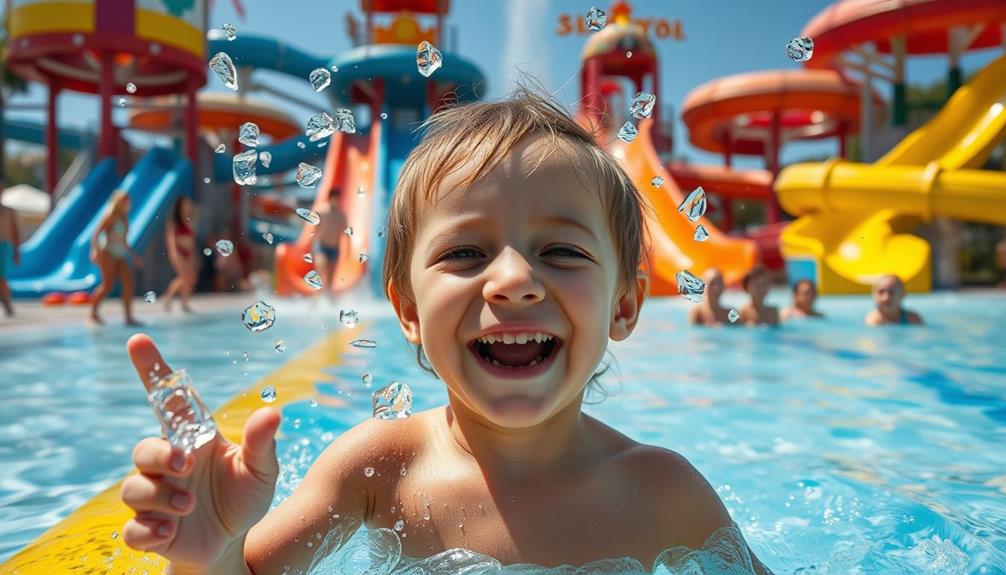
When you're aiming to freeze the dynamic splashes at a water park, understanding flash duration becomes essential. In high-speed photography, the duration of your flash can make or break your shots. To effectively capture splashes without blur, consider these key points:
1. Flash Duration Measurement: Focus on the t 0.1 rating, which indicates the time the flash is at its peak intensity. This is more relevant for freezing motion than the t 0.5 measurement.
Additionally, choosing the right headphone amplifiers can enhance your audio experience while you edit your photos, ensuring you catch every detail.
2. Optimal Equipment: Use speedlites or studio lights with flash durations shorter than 1/1000 of a second. A faster flash duration, like 1/5000 of a second, is ideal for capturing rapid water movements.
3. Shutter Speed Relationship: While shutter speed helps manage ambient light, it's the flash duration that primarily determines the sharpness of your splashes. Make sure your equipment's specifications reflect this.
Always verify flash duration ratings before your shoot. Understanding these elements will enhance your splash photography, allowing you to capture those exhilarating moments with precision.
Advanced Splash Photography Techniques

Mastering advanced splash photography techniques can elevate your images from ordinary to extraordinary. To freeze the action of splashes and droplets, use a high-speed shutter speed of at least 1/1000 sec. Experiment with flash synchronization by setting the flash lag to 0.05 seconds; this guarantees the flash fires right when the splash occurs, capturing those vibrant water details.
Incorporating a programmable controller and intervalometer can greatly enhance your shoot by achieving consistent drop patterns and timing. For a striking effect, use a black or colorful tray to collect water splashes; it not only enhances visibility but also creates a contrasting background for your water action.
Here's a quick reference table to help you optimize your settings:
| Setting | Recommendation | Purpose |
|---|---|---|
| Shutter Speed | 1/1000 sec or faster | Freeze action |
| ISO Levels | 100-200 | Balance exposure |
| Aperture | f/14 | Depth of field and vibrant details |
Creative Inspiration Sources

Finding creative inspiration is essential for taking your splash photography to the next level. To ignite your imagination and enhance your techniques, explore these sources:
1. Liquid Specialists: Immerse yourself in the works of photographers like Barry Makariou and David Lund. Their innovative approaches to capturing splashes and dynamic water movements can spark fresh creative ideas for your own shots.
Additionally, consider how AI-generated music can enhance the atmosphere of your photography sessions, bringing a new layer of creativity to your work.
2. Professional Portfolios: Review Karl Taylor's portfolio for professional tips on splash photography. His creative lighting setups can greatly enhance the visual impact of your water shots, giving you new perspectives on how to illuminate your subjects.
3. Photography Communities: Join online photography forums and communities. Sharing your splash photography with fellow enthusiasts not only allows you to receive valuable feedback but also helps you discover new techniques and ideas that push creative boundaries.
Post-Shoot Cleanup Tips

After an exhilarating day of capturing splash photography, efficient post-shoot cleanup is essential for preserving your gear and maintaining a tidy environment.
Start by gathering your microfiber cloths and paper towels to quickly wipe down your camera gear and any splashed surfaces. This helps prevent water damage and keeps everything clean.
If you've been shooting near pools or fountains, use a squeegee to remove excess water from surfaces, minimizing the mess during cleanup.
Organize a cleanup station with bins for wet items and trash bags for disposables, ensuring effective waste management and a neat shooting area.
Once you've packed up, store all equipment in a dry area.
Wrap your camera bodies in protective plastic to guard against moisture intrusion.
Always check your gear for any signs of water entering sensitive areas, and dry off everything thoroughly before storing it away.
Protecting Your Equipment

Water parks can be a photographer's paradise, but keeping your gear safe from splashes and moisture is vital. Protecting your camera equipment guarantees you can capture those perfect action shots without worrying about water damage.
Here are three effective strategies to safeguard your gear:
- Use Waterproof Housing or Protective Cover: Invest in a waterproof housing or a protective cover specifically designed for your camera model. This shields your camera from water exposure and unexpected splashes.
- Maintain a Safe Distance: Utilize longer lenses to keep a safe distance from the action. This not only helps you capture close-up shots but also minimizes the risk of water intrusion onto your camera when things get splashy.
- Secure Your Gear with a Camera Strap: Always employ a camera strap to prevent accidental drops, especially when leaning over wet surfaces. This way, you can focus on snapping those dynamic shots without worrying about your camera falling.
Frequently Asked Questions
What Shutter Speed for Water Splash Photography?
For water splash photography, you'll want a shutter speed of at least 1/1000 second to freeze the action. Experiment with speeds between 1/500 and 1/2000 second for sharp, vibrant images in various lighting conditions.
How to Make a Splash Picture?
Did you know that using a fast shutter speed can increase sharpness by over 70%? To make a splash picture, position yourself at eye level, shoot continuously, and experiment with angles for dynamic results.
What Equipment Do You Need for Splash Photography?
For splash photography, you'll need a DSLR or mirrorless camera, a fast 100mm macro lens, a sturdy tripod, and external flash. Don't forget protective coverings to keep your gear safe from water damage.
How Do You Make Water Look Good in Pictures?
Did you know that photos taken during golden hour can increase engagement by over 30%? To make water look good, use a fast shutter speed, experiment with angles, and incorporate vibrant colors for stunning contrast.
Conclusion
Now that you're armed with these water park photography tips, you're ready to capture those perfect splashes! Remember, "A picture is worth a thousand words," so don't hesitate to get creative and experiment with different angles and techniques. With the right gear and a bit of practice, you'll be snapping stunning shots in no time. So grab your camera, plunge in, and let the fun begin—your masterpiece awaits! As you explore the vibrant scenes around you, take a moment to consider the psychology behind water park design and how it influences the emotions and energy of your photos. From the exhilarating curves of water slides to the calming blues of the wave pools, these elements are intentionally crafted to evoke feelings of joy and adventure. Tap into this atmosphere and let it guide your creative vision—you’ll find that every corner holds the potential for a unique and thrilling shot!



